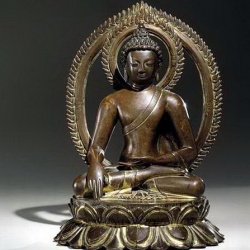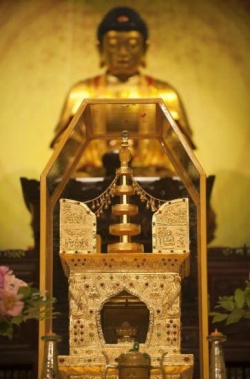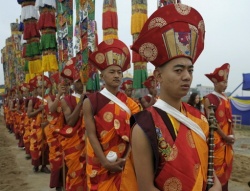Hua-yen school
The Hua-yen school derived its name from the title of the Chinese translation of Avatamsaka-Sutra. Avatamsaka literally means "Flower Garland". (Fig.1 Hua-Yen Temple)
The first complete translation of the Avatamsaka Sutra in Chinese was done by Buddhabhadra(359-429) between 418-421. This translation is in sixty fascicles and has thirty-four chapters. It is also referred to as "Sixty Hua-yen" or "Old Sutra".
A latter translation of the Sutra under the same title was completed by Siksananda(652-710) in Tang dynasty. This translation is in eighty fascicles and has thirty-nine chapters. It is also referred to as "Eighty Hua-yen" or "New Sutra".
The third translation of the Sutra was done by Prajna not too long after the second translation. The origin of this Sanskrit source was from different part of India and the content was similar to the last forty fascicles of the Avatamsaka-Sutra therefore it is called "Forty Hua-yen" or "Last Hua-yen".
The first two translations are quite similar, the second being perhaps more literal and somewhat longer because it contains new material not found in the earlier version. And the last one is a re-translation of the second part of the Sutra with minor regional differences.
As one of the longest texts in the Buddhist Canon, the Avatamsaka is one of the most comprehensive compendiums of the Buddhist teaching. It was held in the highest esteem by the followers ever since its presence in Chinese Buddhist society.
The main subject of this Sutra is the description of The Buddha's Enlightenment. It provides a detail guide for practitioners to pursuit the Bodhisattva's Path, from the Awakening of Bodhicitta to the accomplishment of perfect Buddhahood. The Bodhisattva Path is presented in four sets of ten stages, culminating with the two levels of Enlightenment, the final goal of Mahayana Buddhism.
The school was officially founded by Fa-tsang (or Shan-shiang 643-712) based on his scholarly contribution to the Hua-yen theory. His religious work attracted a lot of attention and eventually produced significant influence on the emperor. With strong political support from the emperor, Fa-tsang was able to create a new school system that outspread quickly during the time. Even this school was started from Fa-tsand, its earliest theory and structure go back to the masters Tu-shun(or Fa-shun, 557-640) and Chih-yen (602-668), who are considered the first two patriarchs of the Hua-yen school. Tu-shun's "Five levels of teaching" and "Ten profound gates" formed the root of the school system. And he was regarded by his successors as an incarnation of Manjushri.
Further important representatives were Cheng-kuan (or Ching-liang 738-839), under whom the school gained great influence. Cheng-kuan was the master of several emperors. With his special relationship to the political leaders, Cheng-kuan earned the title "the Hua-yen Bodhisattva" and was regarded as the fourth Patriarch. The fifth Patriarch of the school was Tsung-mi (780-841), who initiated the concept of merging Zen and Hua-yen in one school. After the Death of Tsung-mi, Hua-yen declined during the general suppression of Buddhism in China.
The Hua-yen school distinguishes itself from the other Chinese Buddhist Schools in an important viewpoint. The practice in this school concentrates on the relationship between Phenomena and not on that between Phenomena and the absolute. This notion is called the "universal causality of the Dharma-dhatu (universal principle)," i.e., everything in the Universe arises out of itself and the principles of all activities (Phenomena) are essentially one, and that unity is essentially plural. Since all things participate in a unity and this unity divides into the many, therefore the manifold is unified in this one. Based on the theory, there are an infinite number of Buddhas and Buddha realms in the Universe and they all share the same True Buddha Body and live with the same principle in the similar Buddha realm, they are just like individual waves of the same sea and these waves cannot exist independently. Because the equality of all things and the dependence of all things upon one another are so essential in this school, this teaching is known as the "teaching of totality".
From this point of view everything in the World, whether animate or inanimate, is an expression of the highest principle (Dharma-dhatu) and is thus one with Buddhamind. This view is explained in the division of the Universe into four realms and in the thesis of the six characteristics of things. They are in either a state of "true suchness" (Tathata): (I). The static aspect of which is the realm of "principle" ("li"). (II). The dynamic aspect of which is the realm of Phenomena ("Shih"). These two realms are so interwoven and dependent on each other that the entire Universe arises as an interdependent conditioning. The four realms of the Universe are as follows:
- The realm of Phenomena: The Small teaching and Begin teaching define this realm as the World of Dharma.
- The realm of the principle (absolute): The Begin and Sudden teachings define this realm as the World of Dharma.
- The realm in which Phenomena and principle mutually interpenetrate: The End teaching defines this realm as the World of Dharma. It touches the basis of Middle Way and provides the integrated system for the Phenomen and principle realms.
- The realm in which all Phenomena exist in perfect Harmony: This is the teaching of totality. Based on the theory, the Round teaching is able to resolve the different viewpoints from results of different phenomenal experiences.
To explain these many-to-one, one-to-many, and many-to-many relationships of Phenomena, Hua-yen's teaching defines that the Dharma possesses the six characteristics:
- Universality: The view of corresponding object as a whole.
- Specificity: The parts of the object only fulfill the specific function and are distinct from each other.
- Similarity: All the parts consist in the fact that they are part of the object.
- Distinctness: All the parts express the distinct functions in the object.
- Composition: The characteristic of integration that all parts together make up the object.
- Decomposition: Every part takes its own particular place and the object can be completed only if each part show the nature of their differentiation.
Like the Tien-Tai school, Hua-yen undertakes a division of The Buddha's teaching into different categories. Unlike Tien-tai's intention of integrating different Indian Buddhism theories, Hua-yen's focus was more on synthesizing different viewpoints of Chinese schools during early Tang Dynasty. This school classified Buddhist scriptures and doctrines on five levels. With its own teaching as the highest and most complete teaching of all. These five levels are:
- Small teaching: The Hinayana teaching. It is considered the "small vehicle" teaching because it only focuses on individual Liberation and it appears in the Agamas period.
- Begin teaching: The beginning teachings of the Mahayana, which sees all dharmas are Emptiness because they arise in a conditioned fashion. And because it denies all beings possess Buddha-nature (with the potential of being an Enlightenment one) therefore it is considered an elementary (or begin) teaching. As advocated by the Fa-hsiang and San-lun schools.
- End teaching: The end teaching of the Mahayana. On this level all things are considered to arise with causality by Emptiness nature, and their individual independent existence is admitted. As presented by the Tien-Tai school.
- Sudden teaching: Unlike the previous two teachings that require gradual practice, Enlightenment can be attained suddenly through special techniques taught in the teaching. This is the stage of Zen.
- Complete (Round) teaching: The ultimate and complete teaching of The Buddha's teaching, the teaching of the Hua-yen school. Where all beings and activities (Phenomena) exist in perfect Harmony.


